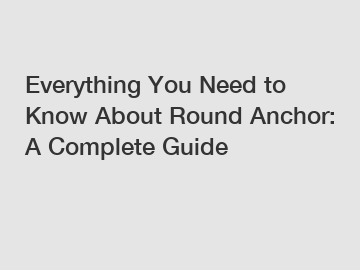Apr. 07, 2024
When it comes to anchoring your boat, a round anchor is a reliable and essential tool that every boater should have in their arsenal. Whether you're a seasoned sailor or just getting started in the world of boating, understanding how to properly use a round anchor can make all the difference in ensuring your safety and the safety of your vessel.
In this comprehensive guide, we'll take a deep dive into everything you need to know about round anchors, including their benefits, how to properly use them, and tips for keeping them in top condition. So, sit back, relax, and let's dive into the world of round anchors!
Benefits of Round Anchors.

Round anchors, also known as circle anchors, are one of the most commonly used types of anchors due to their simplicity and effectiveness. The rounded shape of these anchors allows them to dig into the sea floor and hold your vessel securely in place, even in rough waters.
One of the main benefits of round anchors is their versatility. They can be used in a wide variety of seabeds, including sand, mud, and gravel, making them a great option for boaters who frequent different types of waterways. Additionally, round anchors are easy to deploy and retrieve, making them a convenient choice for boaters of all experience levels.
Proper Use of Round Anchors.
Using a round anchor properly is crucial for ensuring the safety of both you and your vessel. Here are some tips for using a round anchor effectively:
1. Choose the right size anchor for your vessel. Make sure to select a round anchor that is appropriate for the size and weight of your boat to ensure it will hold securely in place.
2. Find a suitable anchor location. Before dropping your anchor, be sure to survey the area to ensure it is free of obstacles and other boats. Look for a spot with good holding ground for the best results.
3. Lower the anchor properly. When dropping your anchor, lower it slowly and steadily to allow it to set properly in the sea floor. Avoid simply throwing your anchor overboard, as this can cause it to drag and not hold as securely.
4. Allow the anchor to set. Once your anchor is on the sea floor, give it time to dig in and set properly before putting tension on the rode. If you have doubts about whether the anchor is holding, give it a gentle tug to test its strength.
5. Check the anchor regularly. While anchored, periodically check the anchor to ensure it is still holding securely. If you notice any dragging or movement, it may be time to re-set the anchor or find a new location.
Maintaining Your Round Anchor.
To ensure your round anchor stays in top condition and continues to perform effectively, it's important to properly maintain it. Here are some tips for keeping your round anchor in peak shape:
1. Rinse your anchor with fresh water after each use to remove any salt buildup that could corrode the metal.
2. Store your anchor in a cool, dry place to prevent rust and corrosion.
3. Check the anchor for any signs of wear or damage before each use, including bent or broken prongs and rusty spots.
4. Replace any worn or damaged parts of the anchor promptly to ensure it continues to function properly.
By following these tips for using and maintaining your round anchor, you can enjoy safe and secure anchoring wherever your boating adventures take you.
In conclusion, round anchors are an essential tool for any boater looking to safely anchor their vessel in a variety of water conditions. By understanding the benefits of round anchors, how to use them properly, and tips for maintaining them, you can ensure smooth sailing on the open seas. So, next time you're out on the water, make sure you have a round anchor on board to keep you anchored in place and enjoy your time on the water to the fullest.
If you want to learn more, please visit our website Where is pre-tensioning and post tensioning?, What is PC Strand used for?, What are the advantages of post tensioning over pre-tensioning?.
Previous: PC Strand: The Secret Weapon for Stadiums?
Next: Unlocking the Secrets of Low Relaxation Prestressed Concrete Strand: Expert Insights
If you are interested in sending in a Guest Blogger Submission,welcome to write for us!
All Comments ( 0 )